Oculus Rift Review
Oculus Rift Review
It keeps getting better
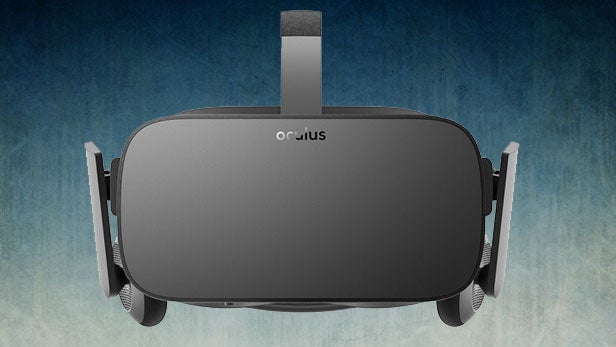
Verdict
Pros
- Incredible, new experience
- Light and robust
- Simple setup
- Strong launch lineup
Cons
- Images could be sharper
- VR sickness an issue with some games
- No motion controls
Key Specifications
- Review Price: £499.00
- 1,200 x 1,080 resolution AMOLED screen for each eye
- Requires a powerful gaming PC
- Xbox One controller included, Rift Controllers coming later
- Remote control
- Head-tracking sensor
- Recommended use 13 years and older
When the Oculus Rift first launched, it fell behind the HTC Vive for two crucial reasons: there were no motion controls and it couldn’t handle room scaling.
Add to this the HTC Vive’s ties to the more popular and established Steam store, and it was impossible to fully recommend the Oculus over its admittedly more expensive rival.
Since then, however, things have become a little more interesting in the world of VR. For starters, we’ve seen the arrival of the PlayStation VR. While the headset doesn’t match the tech specs of either the Vive or the Oculus Rift, it’s significantly cheaper and works with any PlayStation 4, which makes it far better value. The Oculus and Vive still requires a gaming PC with at least an Nvidia GeForce GTX 1060, quad-core Intel Core i5 CPU and 16GB of RAM to work.
We’ve also seen the arrival of the Oculus Touch remotes, which make things significantly more competitive in the top-end VR market. The Touch controllers are Oculus’ answer to the HTC wands and let the headset match, if not beat, the HTC Vive when it comes to immersive gaming.
The controllers use twin sensors to track and detect gamers’ movements and are easier to set up than the Vive, which requires a wee bit of DIY to get working. I found the system worked best with the two sensors around a metre apart on a flat surface, pointing at the centre of your desired play area.
The controllers are significantly more ergonomic than the HTC Vive’s Wands, thanks to the fact that they use a more traditional joystick and button layout. The Vive Wands have a slightly atypical trackpad system that takes a while to get used to.
Related: PlayStation VR vs Oculus Rift
Watch: Oculus Touch review
The Oculus Touch’s twin sensors offer limited room scaling, which means they can track your movements in a desired play area. This makes fast-paced shooters, such as Supershot, an absolute blast to play. The only downside is that with the setup out of the box, the controllers don’t work too well when you have your back to the sensors, which is an issue in games where you have to explore, or move around a lot, such as Arizona Sunshine.
To match the room-scaling experience of the HTC Vive, which has three sensors out of the box, you have to shell out for a third Oculus sensor. This makes it one of the most expensive VR options and results in setup being a little trickier too. To get it to work you’ll have to trail a wire from your PC to a point at the back of your play area, which isn’t ideal.
The fact the headset is cabled is also still a faff on room scaling games. On several occasions I nearly garroted myself while playing Arizona Sunrise when trying to quickly escape a stealthy zombie. However, this is an issue on the Vive as well.
On the plus side, the Oculus Store has grown massively. The Touch controllers launched with 53 compatible games; since then, that number has continued to grow. However, variety is still lacking when it comes to VR gaming as a whole. Since the platform is so young, developers haven’t really figured out what to do with it. Most of the games are arcade-style shooters or puzzlers as a result. Despite the increased number, hardcore titles are still lacking, as are games that are doing something different with VR.
The lack of variety means the Oculus has spent the last few weeks gather dust and only really comes out as a party piece when friends come over. I can’t help but wish someone would try something new, like say Skyrim in VR or a new Steel Battalion.
Steam continues to feel more developed; the Oculus Store’s curation is still undercooked, and having a second marketplace installed is a faff. This is especially true with Oculus: although possible, getting games to install on a different SSD to the one on which the store is installed can prove tricky.
Oculus Rift long-term verdict
VR is still a very young platform, and no headset has managed to so far get it 100% right. The lack of interesting games, despite an impressive increase in numbers, makes the platform feel underdeveloped as a whole.
Despite this, Oculus has taken bold strides forward, from being one of the least appealing VR platforms to a valid contender for the top slot thanks to the arrival of Oculus Touch. Oculus has also done stellar work courting developers, which will hopefully lead to a greater variety of games in its Store in the very near future – we hope.
Read our original Oculus Rift review by Evan Kypreos below
What is the Oculus Rift?
The future is here. You’ll hear that frequently from virtual reality enthusiasts – and it starts with the Oculus Rift.
They’re not wrong. The Oculus Rift is undoubtedly the start of something special, a new way to play games that sows the seeds for not only a technological and social revolution.
For more than two weeks using the Oculus Rift, I’ve immersed myself in awe-inspiring worlds and devoured every possible VR experience going. I’ve used it with a top-end PC as well as one that meets only the minimum hardware requirements, and I’ve compared the Rift against its main rival: the HTC Vive. I’ve lived in VR, and on the whole I’ve loved it.
The problems that remain shouldn’t really put off early adopters. If you have, or can afford, the hardware to run VR and have a desire to be at the cutting-edge of tech then the Oculus Rift certainly delivers; all others can afford to wait. This is a great start to the VR revolution.
Video: Watch our in-depth Oculus Rift vs HTC Vive comparison
Getting started in VR
Oculus is aware that first impressions count, and this shows in the clever design of the carry case. Securely slotted in is the Oculus Remote, a head-tracking sensor on a slender stem, an Xbox One controller and, of course, the Rift headset itself.
Setting up the Oculus Rift is a breeze, but you’ll need a reasonable amount of space to use the device – I found a swivel chair and a 1.5m x 1.5m space about right. Provided your PC is ready to go, you can be up and running within minutes of unpacking the box. Setting up the Vive, by comparison, is a more involved process – it took me well over an hour.
Related: PlayStation VR review
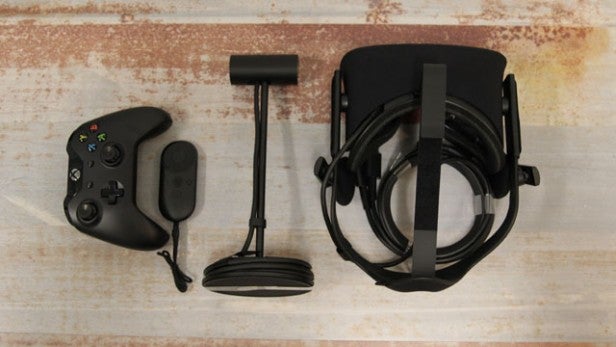
Oculus has done everything right when it comes to design, too. It’s built a headset that’s light yet robust, including decent integrated headphones that won’t weigh you down. It’s good-looking, if a little austere, but it doesn’t look or feel like a work in progress. It’s ready.
The Oculus Remote is a nice addition, too. A lanyard keeps it on your wrist and you can easily control volume and move around menus. It’s not for gaming, but it’s great for just sitting back and watching videos or trying out some of the many non-gaming VR experiences.
Its lightness and the remote may well be the biggest benefits the Oculus Rift has over its main competitor – the HTC Vive – which is a good 200 grams heavier. Spend a few hours using any VR headset and you’ll quickly appreciate how being light and comfortable is high on the ‘must-have’ list of features. The Rift ticks both boxes.
It manages to keep external light out well too, thanks in part to my big head and nose. Some colleagues with smaller features found that light leaks in from the nose arch. It could do with an additional bit of foam for some users.
Related: Best VR games
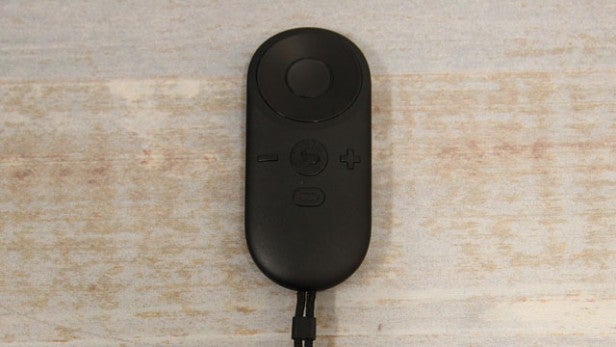
Since the Oculus Rift doesn’t weigh much, I’ve worn it for hours at a time without any discomfort – although that might change in warm weather when my head gets hot and sticky. On some occasions I donned the headset during the day and took it off after the sun had gone down. I had no idea how much time had passed.
Virtual reality is that entrancing. It isolates you entirely from the real world and envelops you in an imaginary one. At its best, VR is everything the hype claims it to be.
Living with Oculus Rift
The best place to start your Oculus Rift experience is not with a game but with Oculus DreamDeck – eight demos which give you a feel of what virtual reality is all about, two of which really stand out.

The first is a steampunk inspired cityscape. You stand at the top of a huge skyscraper and look around you to see the stunning vista – an impressive sight in its own right. Look down, though, and you experience the first way your mind can be tricked by virtual reality. Hundreds of feet below you are cars and tiny people going about their daily lives. The effect makes you take a step back so you don’t tumble into the abyss. Vertigo can feel very real in VR.
The second places you in a museum of natural history. A noise brings your attention to a long corridor from which a huge T-Rex comes hurtling towards you, stopping just in time to deliver a bellow, complete with globules of saliva, right in your face. You can almost feel the warm breath.
It’s brilliant to watch from the outside as well. One of the TrustedReviews team was physically cringing and shaking during his experience with the colossal carnivore.
Oculus Home, your portal into all the VR games and experiences available on the Rift, is full of nuggets like these. I particularly enjoyed the David Attenborough documentary accessed via Oculus Video, once again showing off the grandeur of dinosaurs in a way a TV never could. Ok, maybe I’ve got a thing for the extinct giants.
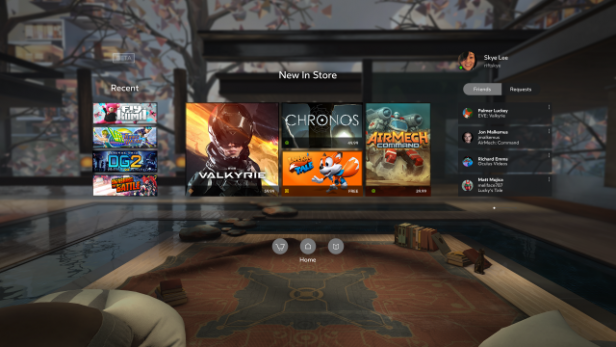
But gaming has always been the primary focus of the Oculus Rift and thankfully it doesn’t disappoint. There are 30 launch titles – that’s more than the Xbox One and PS4 started with – some of which are excellent.
Two come bundled with the Oculus Rifts: Lucky’s Tale and Eve: Valkyrie. Lucky’s Tale is a beautiful platformer that shows traditional games don’t just play well on the Oculus Rift, they’re enhanced by it.
The visuals are great and moving Lucky around his colourful surroundings and dispatching the cute bad guys with whips of his fluffy tail works brilliantly in real 3D.
The standout game for most, though, will be Eve: Valkyrie. This dogfighting sim in space has been in the works for years and the effort has paid off. I find myself spending hours at a time spinning through space, firing missiles and avoiding them – it is a perfect use of virtual reality, even though it took my brain a little while to get used to it.
This sort of immersive virtual reality isn’t like anything else I’ve experienced and it’s impossible to give anyone a realistic interpretation with words or even videos. It’s something that needs to be experienced first hand.
And if you think you know what the Oculus Rift can do because you’ve tried Google Cardboard or even Gear VR then you’re wrong. The Rift is on an entirely different planet to those fun, but predominantly passive experiences.
Related: Best Oculus Rift Games and Apps
As seminal and progressive as some moments with the Rift are, I was sometimes left wishing it was a little slicker, a bit more advanced.
It starts with the screens. A combined resolution of 2,160 x 1,200 looks good on paper, but you can’t help but notice the pixels when they’re stretched just a few inches from your eyes and magnified by lenses. It’s worse on big swathes of a single, light, colour than during busy games, but there is a lack of sharpness to graphics, a hazy, diagonal, array that is particularly noticeable during more intense gaming experiences.
How much of an issue you find this depends on how much you value having such a huge field of view and, therefore, level of immersion. I can forgive the fuzzy edges for the all-round experience, others may not.
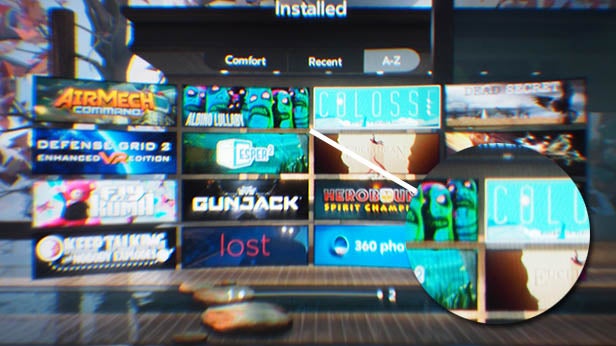 Attempting to take a picture through the lens makes it looks a lot worse than it is, but this image gives you an idea of the issue
Attempting to take a picture through the lens makes it looks a lot worse than it is, but this image gives you an idea of the issue
Oculus Home is a little tricky to navigate, too. There’s no search, for example, so you have to try and find an engaging video or sort through your games library by flicking through menu after menu. It’s not too bad now, but the more content that becomes available the more difficult finding what you want will get.
The fact that every interaction you can have with the Rift is managed through Oculus Home via the remote or controller feels limiting. Within a few hours I was wishing there was another way to get things done. If there was ever a perfect use-case for voice control, like Siri or Cortana offers, then it’s for virtual reality, when your senses are otherwise engaged. The Rift does have an integrated mic so I’m keeping my fingers crossed that voice interaction is in the pipeline and the mic isn’t just there for swearing at useless teammates.
You can’t use the Rift like a monitor, either, something you could do on developer versions using third-party apps.
It’s early days yet, though, and Oculus Home is a very solid start when you compare it to Steam, which was full of holes when it first launched. Steam is a powerhouse these days, but SteamVR does not properly support the Rift. I managed to get some applications to start but there’s no way to control them. With Valve partnering with HTC to produce the Vive I don’t see this changing any time soon. Unfortunately, the software isn’t the only thing that needs development.
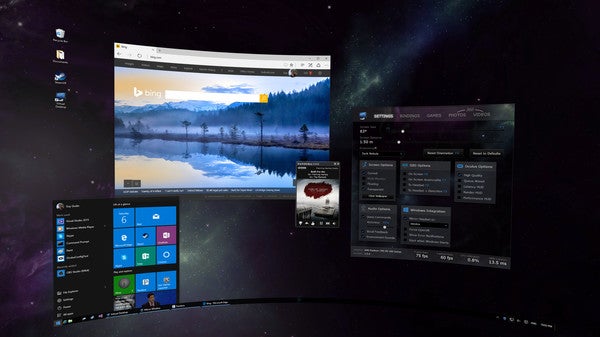 Virtual Desktop is not yet available for the Rift
Virtual Desktop is not yet available for the Rift
Virtual reality is best experienced with an input device suited to the task and an Xbox One controller isn’t ideal. It works brilliantly for Eve: Valkyrie and Lucky’s Tale, but these are games that can also be played on a monitor or TV.
The HTC Vive comes bundled with a controller for each hand that lets you express yourself better in a virtual environment. You’re able to to see your hands and reach and grasp. More importantly you can aim and shoot, in different directions and at the same time if you want, as if you’re in a John Woo movie.
The Oculus Rift is already lagging a little as its vision of a VR specific controller, called Oculus Touch, won’t launch until the latter half of the year and we still don’t know how much it’ll cost.
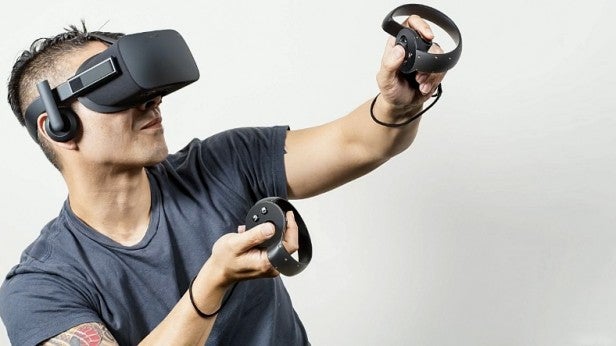
That doesn’t make the Vive better, just different. It’s heavier and a lot more complicated to set up – both headsets have their own strengths and weaknesses – but VR really needs a dedicated controller to unlock its full potential.
Related: Oculus Rift vs HTC Vive
The biggest issue with the Oculus Rift, though, isn’t one it suffers in isolation. Virtual reality sickness, a feeling of queasiness and disorientation, rears its nauseating head in spite of the huge strides Oculus has already taken to eliminate it.
Adr1ft, a game that put me in a similar predicament to Sandra Bullock’s in Gravity, made me feel physically sick. Moving around in zero-g made my head feel strange right away and after less than 20 minutes I had to remove the Rift and lie down for an hour.
My experience with Project Cars was even worse, Just five minutes of racing around a track and I had to stop, cold sweat on my brow and a waves of nausea pounding my stomach.

There are only a few games that seem to affect me adversely. They’re invariably first person and involve both forward and side-to-side motion combined with the ability to look around – anything with a fixed camera or where the player is in a stationary position is absolutely fine and I have also find myself becoming less easily affected the more I use the Rift.
This is a problem game developers and Oculus are aware of. There are three “Comfort” ratings given to games. A green square denotes a “Comfortable” experience, a yellow square a “Moderate” one and an orange diamond “Intense”. Intense denotes anything with complex movement and in my experience means you are more likely to feel a little off kilter.
Bottom line: you can thoroughly enjoy the Oculus Rift without playing intense games. Not one of my friends or colleagues who played Comfortable or Moderate games felt any ill effects at all. If this is still a worry for you then try and experience the Rift first hand before you buy it. Of course if you’re anything like me you’ll be hooked as soon as you give it a go.
How good does your PC need to be for VR?
You’ll need a PC that can handle the extreme demands of the Rift to help minimise some of its bigger issues.
The Rift has dual 1,080 x 1,200 pixel AMOLED screens, one for each eye, with a refresh rate of 90Hz. On top of that Oculus insists that games should run at a constant 90 frames per second (fps) to match the screens’ refresh rate.
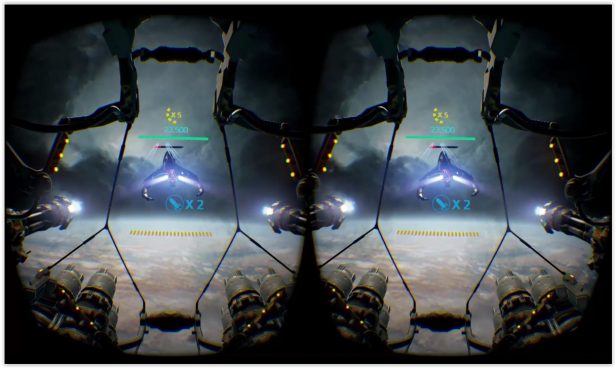 Eve: Gunjack is the highest tech version of Space Invaders yet
Eve: Gunjack is the highest tech version of Space Invaders yet
Let’s just put that in a little context. 60fps is arguably the frame rate to aim for in multiplayer first-person shooters and you need a solid PC to run those on a Full HD monitor. You’ll need roughly three times the GPU power for VR while retaining the same graphical fidelity, which is a big ask. Any gaming rig more than a year or so old probably needs an upgrade, and you can’t simply add another card as the Rift doesn’t support SLI or Crossfire configurations.
Related: Get your PC Oculus Rift ready
I used a couple of VR-ready PCs during testing and found that a minimum spec machine barely cut it. On top of frame drops that strained my eyes and made my brain fizz, I had to run some games at lower graphic settings. For that reason, I recommend going above the minimum system requirements, particularly in the GPU department. The Overclockers Titan Virtual Force PC I used is a great partner since it packs a powerful Nvidia GeForce GT X 980 Ti graphics card, but make sure you go for a larger capacity SSD than comes as standard since, at the moment, all installations are forced onto the primary C: drive.
Video – Trusted Explains: What is VR?
Should I buy the Oculus Rift?
For most people the cost of a top-notch PC and the price of the Oculus Rift will make it a hard sell. At $599 it’s not cheap, but to my mind it’s not expensive for a first-generation product either. And there’s one other small matter to consider – you can be one of the first to invest in what will become a tech revolution. It’s the ultimate product for the adventurous early adopter.
Deciding between the Rift and its competitors is tricky. Having spent several days with the HTC Vive Pre (that’s not quite the final version of the HTC Vive, but pretty close), I think the Oculus is the better experience if you’re mainly interested in gaming. It’s easier to setup and lighter, which lends itself to long sessions. The Vive offers more interesting and interactive casual experiences, but demands more space to get the most from it.
Even when the Rift feels awkward, like a teenager trying to get to grips with an ungainly growth spurt, its potential shines through. Once developers get to grips with VR, and Oculus releases its VR controllers, it could become an absolute must-have.
Verdict
The Oculus Rift is a triumph for every tech head – this isn’t just a step towards the future, it is an almighty leap. It’s by no means perfect, but it’s already fulfilling a healthy fraction of its ultimate potential.


